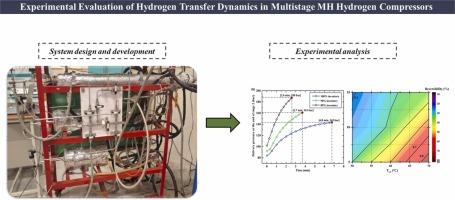多级金属氢化物氢气压缩机中氢气传递动力学的实验评价
IF 6.3
2区 材料科学
Q2 CHEMISTRY, PHYSICAL
引用次数: 0
摘要
基于金属氢化物的氢压缩(MHHC)作为一种非机械式的替代方案越来越受到人们的关注,因为它提供了静音操作和最小的运动部件,解决了机械式压缩机的主要缺点。本研究提出了一种双阶段MHHC的发展和性能分析。设计并制造了两种不同的热化学反应器结构:用于低压阶段的多螺旋翅片冷却管反应器和用于高压阶段的管状反应器。压缩机从40-50 bar的恒压源中吸收氢气,在第一阶段将其压缩到130 bar,然后在第二阶段进一步压缩到300 bar以上。在整个压缩周期中,系统工作温度范围为5-80°C。该研究分析了耦合床温度、氢气库存、循环时间和喷射压力对压缩机性能的影响。耦合过程中的低压床层温度是影响最大的因素,对氢气传递速率和输送压力的影响分别为1.5倍和52%。注入压力对压缩性能的影响很小,而氢气存量对压缩性能有显著影响。当库存量为80%时,压力上升速率下降了74%,在相同的交付温度下,当库存量从100%下降到80%时,交付压力下降了45 bar。尽管在80%的库存条件下,循环时间显著缩短(37.8%),但在100%的库存条件下,压缩率最高,为14.6 L/min。该压缩机的比能耗为55 kJ/L,等熵效率为7.4%。本文章由计算机程序翻译,如有差异,请以英文原文为准。

Experimental Evaluation of Hydrogen Transfer Dynamics in a Multistage Metal Hydride Hydrogen Compressor
Metal hydride-based hydrogen compression (MHHC) is gaining interest as a non-mechanical alternative, offering silent operation and minimal moving parts, addressing key drawbacks of mechanical compressors. This study presents the development and performance analysis of a dual-stage MHHC. Two distinct thermochemical reactor configurations were designed and fabricated: a multi-spiral finned cooling tube reactor for the low-pressure stage and a tubular reactor for the high-pressure stage. The compressor absorbed hydrogen from a constant pressure source of 40-50 bar, compressing it to 130 bar in stage 1, followed by further compression to over 300 bar in stage 2. The system operated within a temperature range of 5-80 °C throughout the compression cycle. The study analyses the impact of coupling bed temperature, hydrogen inventory, cycle time, and injection pressure on compressor performance. The low-pressure bed temperature during coupling was identified as the most influential factor, impacting the hydrogen transfer rate by 1.5 times and delivery pressure by 52%. Injection pressure had a minimal effect, while hydrogen inventory significantly influenced compression performance. The rate of pressure rise dropped by 74% for 80% inventory, with delivery pressure decreasing by 45 bar when inventory dropped from 100% to 80% at identical delivery temperature. Although cycle time reduced significantly (37.8%) for 80% inventory, the highest compression rate of 14.6 L/min was achieved at 100% inventory. The developed compressor demonstrated a specific energy consumption of 55 kJ/L and achieved an isentropic efficiency of 7.4%.
求助全文
通过发布文献求助,成功后即可免费获取论文全文。
去求助
来源期刊

Journal of Alloys and Compounds
工程技术-材料科学:综合
CiteScore
11.10
自引率
14.50%
发文量
5146
审稿时长
67 days
期刊介绍:
The Journal of Alloys and Compounds is intended to serve as an international medium for the publication of work on solid materials comprising compounds as well as alloys. Its great strength lies in the diversity of discipline which it encompasses, drawing together results from materials science, solid-state chemistry and physics.
 求助内容:
求助内容: 应助结果提醒方式:
应助结果提醒方式:


